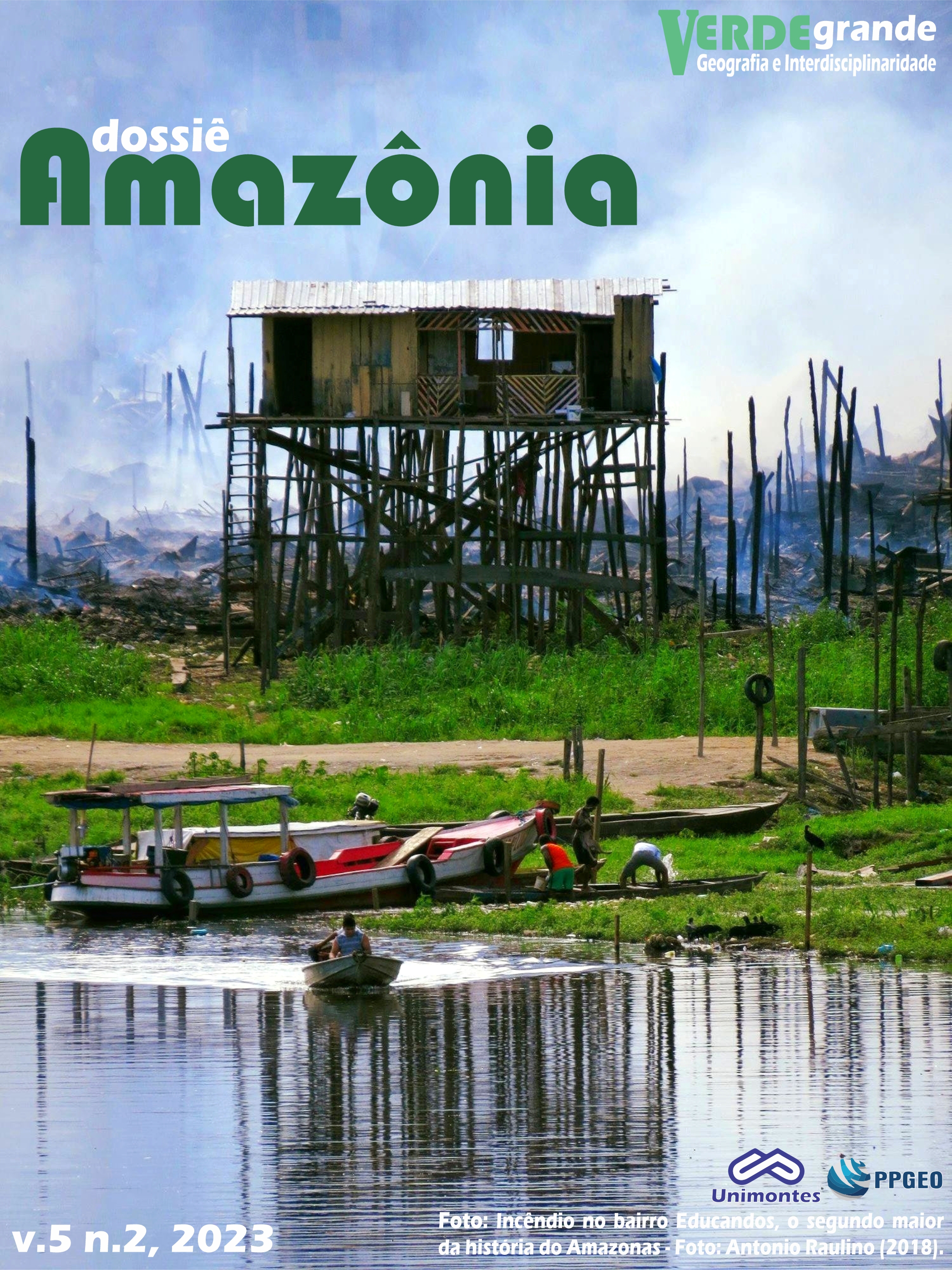Sistema territorial da madeira ilegal no município de Parintins – AM
DOI:
10.46551/rvg2675239520232306326Keywords:
Territorialidade, Madeira ilegal, Rede de sujeitosAbstract
The article analyzes the Territorial System of Illegal Wood in the Municipality of Parintins (AM) from the popular economy, whose objectives are: i) to discuss about the territory and territoriality of the networks of subjects involved in the circuit; ii) demonstrate how illegal wood is distributed and absorbed; iii) analyze transport activities related to illegal timber from the Urban-River Territorial System (STUR); iv) list characteristics of the circuit in the intra-urban space. The methodology used starts from the territorial approach, with the purpose of describing and analyzing the territoriality of the subjects. The data collection instruments were non-directive interviews, application of forms, field observations and the elaboration of maps. As a final result, it was found that this illegal system is articulated through the use of territory and the territoriality of a network of subjects that extract, distribute, absorb and transport illegal wood, benefiting the urban nodes of the city of Parintins.
Downloads
References
ALIER, J. Martinez Alier. O Ecologismo dos Pobres: conflitos ambientais e linguagens de valoração, São Paulo: Contexto, 2011.
ARAÚJO ROSA, Nelson; MARTINI, Adriana; Uhl, Christopher. Espécies Madeireiras da Amazônia Potencialmente Ameaçadas. Belém: Imazon, 1998.
BARTOLI, Estevan. O retorno ao território a partir da cidade: Sistemas territoriais urbano-ribeirinhos em Parintins (AM). Tese (Doutorado em Produção do Espaço Geográfico) – Programa de Pós-Graduação em Geografia da Universidade Estadual Paulista “Julio De Mesquita Filho”. Presidente Prudente, 2017.
BARTOLI, Estevan. Tilheiros: carpintaria naval e sistemas territoriais em Parintins-AM. Desenvolvimento e Meio Ambiente (UFPR), v. 51, p. 43-62, 2019a.
BARTOLI, Estevan. Cidades na Amazônia: Centralidades e Sistemas territoriais na sub-região do Baixo Amazonas (AM). Revista Espaço e Economia, v. 20, p. 1, 2020.
BARTOLI, Estevan. Sistemas Territoriais Urbano-Ribeirinhos: uma proposta metodológica para análise de cidades de dinâmica fluvial e ribeirinha na Amazônia. In: CASTRO, Claudio Eduardo de; FILHO, José Sobreiro; SAQUET, Marcos Aurélio; VINHA, J. F. de S. C. (Orgs.). Geografias Fora do Eixo: por outras Geografias feitas com práxis territoriais / Londrina, PR: Editora Liberdade / EDUEMA, 2022. p. 231-262.
BARTOLI, Estevan. PINHEIRO, Heitor. Atlas de Parintins e Microrregião –Planejamento Territorial e Urbano. Manaus, EDUA, 2022.
BRASIL. Lei nº 9.605, de 12 de fevereiro de 1998: Dispõe sobre as sanções penais e administrativas derivadas de condutas e atividades lesivas ao meio ambiente, e dá outras providências. (Lei dos Crimes Ambientais), 1998.
FERNANDES, Bernardo Mançano. Sobre a tipologia de territórios. Expressão Popular. 1. ed. São Paulo, p. 197-215, 2008.
FERREIRA, Márcio Antônio Couto. Transporte fluvial por embarcações mistas no Amazonas: uma análise do trecho Manaus-Coari e Manaus-Parintins. Tese (Doutorado em Ciências do Ambiente e Sustentabilidade na Amazônia) – Universidade Federal do Amazonas. Manaus, 2016.
GEORGESCU-ROEGEN. O Decrescimento: entropia, ecologia e economia. in: GRINAVALD, J. RENS, I. (orgs.). O Decrescimento: entropia, ecologia e economia. São Paulo: SENAC, 2012.
MAGNAGHI, Alberto. Il progettolocale. Torino: BollatiBoringhieri, 2010.
MOLION, L. C. B. Climatologia Dinâmica da região Amazônica: mecanismos de precipitação. Revista Brasileira de Meteorologia, 2(1): 107-117, 1987.
PICOLI. Fiorelo. Amazônia - O Silêncio das Árvores: Uma abordagem sobre a indústria de transformação. Sinop: Fiorelo, 2004.
RAFFESTIN, C. A produção das estruturas espaciais e sua representação. In: SAQUET, M. e SPOSITO. Territórios e territorialidades. Teorias, processos e conflitos.São Paulo: Expressão popular, 2009.
RAFFESTIN, Claude. Por uma geografia do poder. São Paulo: Ática, 1993.
SAQUET, M. A.; BRISKIEVICZ, M. Territorialidade e identidade: um patrimônio no desenvolvimento territorial. Caderno Prudentino de Geografia, São Paulo. v. 1, n. 31, p. 3-16. 2009.
SAQUET, M. A.; SPOSITO, E. S. Territórios e Territorialidades: Teorias, Processos e Conflitos. 1. ed. São Paulo: Editora Expressão Popular. p. 81, 2009.
SAQUET, Marcos Aurélio. O desenvolvimento numa perspectiva territorial, multidimensional e democrática. Resgate, 2011.
SAQUET, Marcos Aurélio. Por uma abordagem territorial. São Paulo: Expressão Popular, 2009.
SILVA, M. A. MALHEIRO, B. C. P. A face Ribeirinha da Orla Fluvial de Belém. In: TRINDADE JR., Saint Clair Cordeiro da; SILVA, Marcos Alexandre Pimentel da (orgs.). Belém. Belém: EDUFPA, 2005.
SPOSITO, Eliseu Savério; SILVA, Késia Anastácio Alves da. Sujeito na Geografia: Uma proposta para se pensar o espaço por meio de diferentes prismas. Revista Caminhos da Geografia, Uberlândia-MG, v. 22, n. 82, p. (173-190), agosto, 2021.
TRINDADE JR. S. C. SILVA, M. A. P. AMARAL, M. D. B. Das “Janelas” às “Portas” para os Rios: compreendendo as cidades ribeirinhas na Amazônia.in: TRINDADE JR. S. C. TAVARES, M. G. Cidades Ribeirinhas na Amazônia. Mudanças e Permanências. Belém: EDUFPA. 2008.
VENTURI, Luis A. Recurso Natural: A construção de um conceito. São Paulo: Espaço e Tempo, 2006.
Downloads
Published
How to Cite
Issue
Section
License
Copyright (c) 2023 Erick Luiz de Souza Andrade Simas; Estevan Bartoli

This work is licensed under a Creative Commons Attribution-NonCommercial-NoDerivatives 4.0 International License.
You are free to:
Share — copy and redistribute the material in any medium or format
The licensor cannot revoke these freedoms as long as you follow the license terms.
Under the following terms:
Attribution — You must give appropriate credit, provide a link to the license, and indicate if changes were made. You may do so in any reasonable manner, but not in any way that suggests the licensor endorses you or your use.
NonCommercial — You may not use the material for commercial purposes.
NoDerivatives — If you remix, transform, or build upon the material, you may not distribute the modified material.
No additional restrictions — You may not apply legal terms or technological measures that legally restrict others from doing anything the license permits.


















 Esta obra está licenciada com
Esta obra está licenciada com 